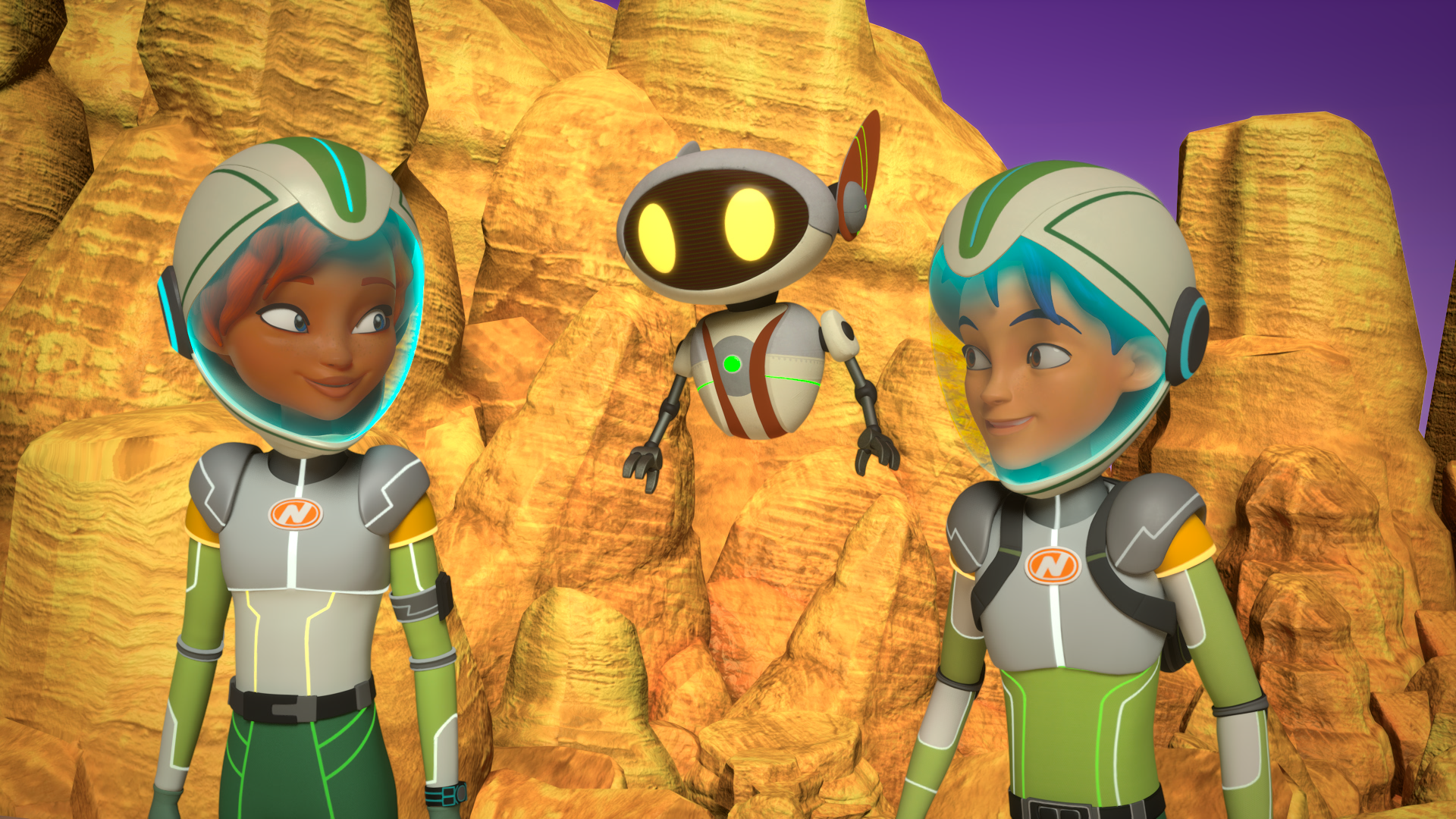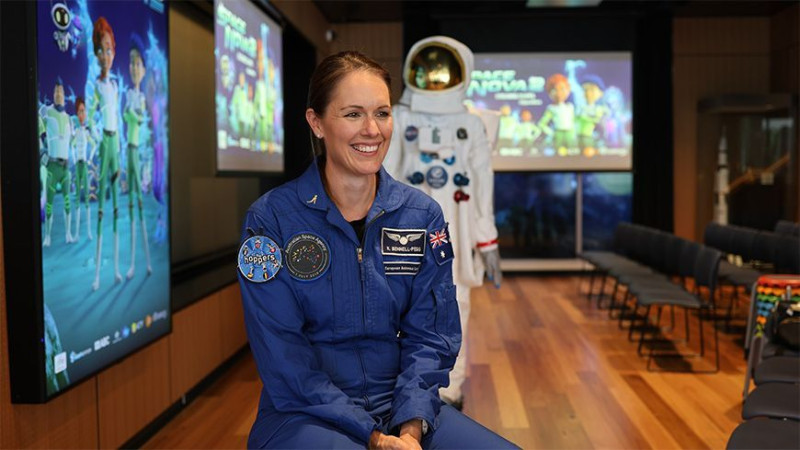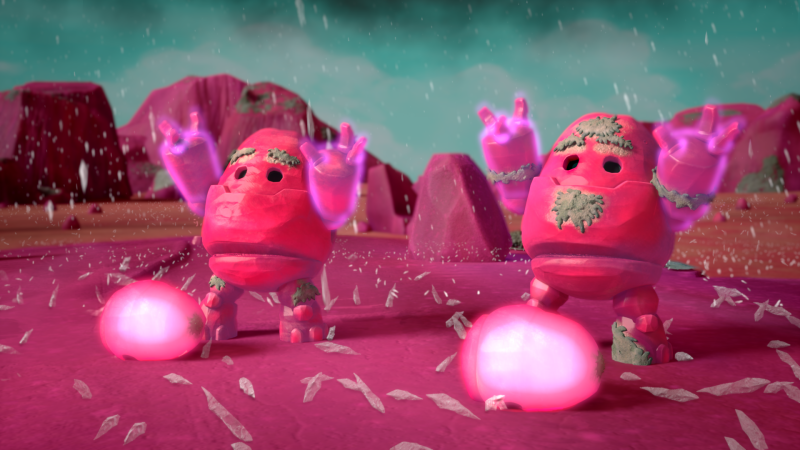
About this resource

The Space Nova Series 2 Education Resource was developed in partnership with the Australian Space Agency and supports teachers to engage Years 3 – 6 students in learning across Science, English, Technologies and The Arts. Centred around themes of space exploration, creative design and storytelling, this resource encourages students to think critically and creatively about fact and fiction.
The resource features a unique interview with Australian astronaut Katherine Bennell-Pegg, who shares her training experiences, career pathway and insights into space science. Katherine also reflects on the scientific accuracy of Space Nova, offering students a unique opportunity to consider fact versus fiction in a science fiction series.
The resource includes three lessons that can be used sequentially or as standalone activities:
Lesson 1: Fact vs Fiction with Australian astronaut Katherine Bennell-Pegg
Lesson 2: Alien Design and Storytelling
Lesson 3: Spacecraft Design Challenge
Australian Curriculum Links
|
|
Year 3 |
Year 4 |
Year 5 |
Year 6 |
|
Biological sciences |
compare characteristics of living and non-living things and examine the differences between the life cycles of plants and animals |
|
examine how particular structural features and behaviours of living things enable their survival in specific habitats |
investigate the physical conditions of a habitat and analyse how the growth and survival of living things is affected by changing physical conditions |
|
Earth and space sciences |
|
identify sources of water and describe key processes in the water cycle, including movement of water through the sky, landscape and ocean; precipitation; evaporation; and condensation |
|
describe the movement of Earth and other planets relative to the sun and model how Earth’s tilt, rotation on its axis and revolution around the sun relate to cyclic observable phenomena, including variable day and night length |
|
Physical Sciences |
identify sources of heat energy and examine how temperature changes when heat energy is transferred from one object to another |
identify how forces can be exerted by one object on another and investigate the effect of frictional, gravitational and magnetic forces on the motion of objects |
|
|
|
|
Year 3 |
Year 4 |
Year 5 |
Year 6 |
|
Knowledge and understanding |
describe how forces and the properties of materials affect function in a product or system |
|
explain how characteristics and properties of materials, systems, components, tools and equipment affect their use when producing designed solutions |
|
|
Processes and production skills |
generate and communicate design ideas and decisions using appropriate attributions, technical terms and graphical representation techniques, including using digital tools |
|
generate, iterate and communicate design ideas, decisions and processes using technical terms and graphical representation techniques, including using digital tools |
|
|
|
select and use materials, components, tools, equipment and techniques to safely make designed solutions |
|
select and use suitable materials, components, tools, equipment and techniques to safely make designed solutions |
|
|
|
use given or co-developed design criteria including sustainability to evaluate design ideas and solutions |
|
negotiate design criteria including sustainability to evaluate design ideas, processes and solutions |
|
|
|
sequence steps to individually and collaboratively make designed solutions |
|
develop project plans that include consideration of resources to individually and collaboratively make designed solutions |
|
|
|
Year 3 |
Year 4 |
Year 5 |
Year 6 |
|
Exploring and responding |
explore where, why and how media arts is created and/or distributed across cultures, times, places and/or other contexts |
|
explore ways that media languages and media technologies are used in media arts works and practices across cultures, times, places and/or other contexts |
|
|
Developing practices and skills |
develop media production skills by exploring ways of shaping ideas using media technologies, images, sounds, text and/or interactive elements |
|
develop media production skills to communicate ideas, perspectives and/or meaning through manipulation of media languages, including images, sounds, texts and/or interactive elements, and media technologies |
|
|
Creating and making |
use media languages, media technologies and production processes to construct representations that communicate ideas, perspectives and/or meaning |
|
use media languages, media technologies and production processes to construct media arts works that communicate ideas, perspectives and/or meaning for specific audiences |
|
|
|
Year 3 |
Year 4 |
Year 5 |
Year 6 |
|
Literature |
create and edit imaginative texts, using or adapting language features, characters, settings, plot structures and ideas encountered in literary texts |
create and edit literary texts by developing storylines, characters and settings |
plan, create, edit and publish written and multimodal texts whose purposes may be imaginative, informative and persuasive, developing ideas using visual features, text structure appropriate to the topic and purpose, text connectives, expanded noun groups, specialist and technical vocabulary, and punctuation including dialogue punctuation |
create and edit literary texts that adapt plot structure, characters, settings and/or ideas from texts students have experienced, and experiment with literary devices |
|
Literacy |
recognise how texts can be created for similar purposes but different audiences |
listen for key points and information to carry out tasks and contribute to discussions, acknowledging another opinion, linking a response to the topic, and sharing and extending ideas and information |
use appropriate interaction skills including paraphrasing and questioning to clarify meaning, make connections to own experience, and present and justify an opinion or idea |
use interaction skills and awareness of formality when paraphrasing, questioning, clarifying and interrogating ideas, developing and supporting arguments, and sharing and evaluating information, experiences and opinions |
|
|
use interaction skills to contribute to conversations and discussions to share information and ideas |
identify the characteristic features used in imaginative, informative and persuasive texts to meet the purpose of the text |
explain characteristic features used in imaginative, informative and persuasive texts to meet the purpose of the text |
|
|
|
use comprehension strategies when listening and viewing to build literal and inferred meaning, and begin to evaluate texts by drawing on a growing knowledge of context, text structures and language features |
use comprehension strategies such as visualising, predicting, connecting, summarising, monitoring and questioning to build literal and inferred meaning, to expand topic knowledge and ideas, and evaluate texts |
use comprehension strategies such as visualising, predicting, connecting, summarising, monitoring and questioning to build literal and inferred meaning to evaluate information and ideas |
use comprehension strategies such as visualising, predicting, connecting, summarising, monitoring and questioning to build literal and inferred meaning, and to connect and compare content from a variety of sources |
|
|
plan, create, edit and publish imaginative, informative and persuasive written and multimodal texts, using visual features, appropriate form and layout, with ideas grouped in simple paragraphs, mostly correct tense, topic-specific vocabulary and correct spelling of most high-frequency and phonetically regular words |
plan, create, edit and publish written and multimodal imaginative, informative and persuasive texts, using visual features, relevant linked ideas, complex sentences, appropriate tense, synonyms and antonyms, correct spelling of multisyllabic words and simple punctuation |
plan, create, edit and publish written and multimodal texts whose purposes may be imaginative, informative and persuasive, developing ideas using visual features, text structure appropriate to the topic and purpose, text connectives, expanded noun groups, specialist and technical vocabulary, and punctuation including dialogue punctuation |
plan, create, edit and publish written and multimodal texts whose purposes may be imaginative, informative and persuasive, using paragraphs, a variety of complex sentences, expanded verb groups, tense, topic-specific and vivid vocabulary, punctuation, spelling and visual features |
Partnership
This resource was developed in partnership with the Australian Space Agency.



